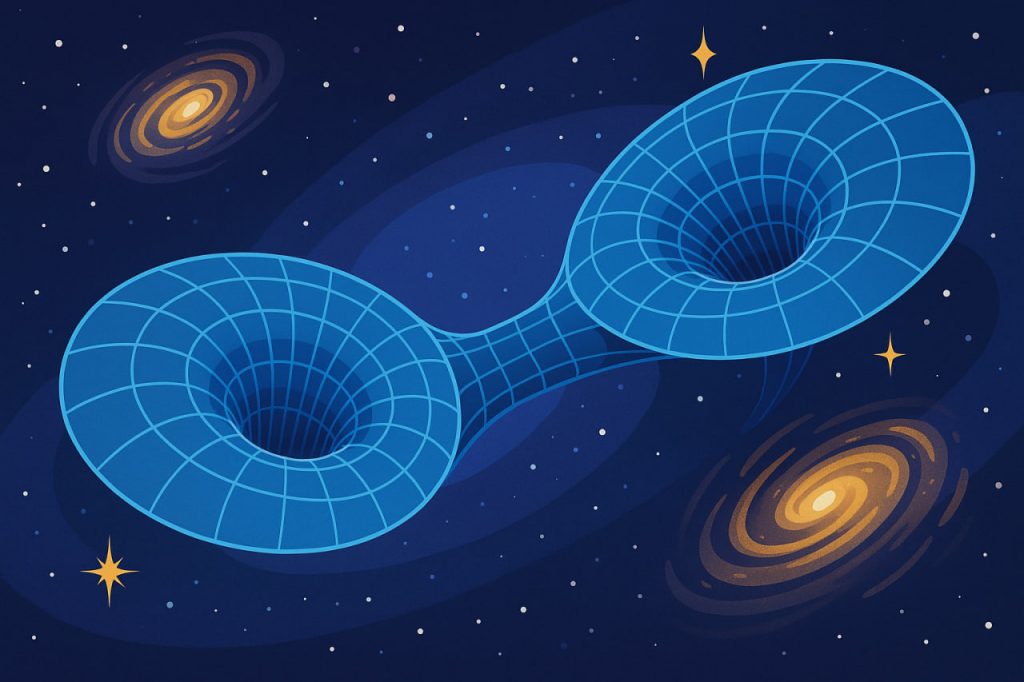Wormholes, also known as Einstein-Rosen bridges, are theoretical passages through space and time that could connect two distant points in the universe. These concepts emerge from solutions to Einstein’s general theory of relativity, which describes how massive objects warp space-time. In theory, wormholes could act as shortcuts across the cosmos, potentially allowing for faster-than-light travel or even time travel. However, to date, no actual wormhole has been observed, and many scientists consider them purely speculative.
How Wormholes Might Work
A wormhole can be visualized as a tunnel with two ends located at different points in space-time. Imagine folding a piece of paper in half and poking a hole through both layers — this hole represents the wormhole, bypassing the distance between two separate regions. According to relativity, extreme gravitational warping caused by massive objects could, in theory, produce such tunnels.
Most theoretical wormholes are based on the Schwarzschild solution to Einstein’s equations, which initially described black holes. Later, it was found that under certain conditions, this solution could imply a bridge between two regions — a wormhole. However, these would be unstable and collapse instantly unless supported by exotic matter with negative energy density.
Exotic Matter and Stability
To keep a wormhole open, physicists believe a special type of exotic matter would be required. This substance would have negative mass or negative energy — properties not known to exist in ordinary matter. Exotic matter could theoretically prevent the wormhole from collapsing under its own gravitational pull.
Quantum theory allows for the existence of such negative energy in certain scenarios, like the Casimir effect, but only on a tiny scale. Creating or finding enough exotic matter to stabilize a wormhole remains purely hypothetical.
Are Wormholes Time Machines?
Some theories suggest that if one mouth of a wormhole moves at near-light speed or is placed in a strong gravitational field, it might experience time differently than the other. This could result in a time shift between the two ends, allowing an object to enter at one mouth and exit at a different time. In essence, wormholes could function as time machines — at least mathematically.
However, this raises issues with causality, or the principle that cause must come before effect. Many physicists argue that natural laws would somehow prevent such paradoxes, perhaps through a phenomenon like the chronology protection conjecture proposed by Stephen Hawking.
Challenges to Their Existence
Despite being fascinating, wormholes face many theoretical and practical problems:
- They may collapse too quickly for anything to pass through.
- They might require conditions that can’t be created in our universe.
- Even if they exist, traversing them could expose travelers to lethal radiation or tidal forces.
- There’s no experimental evidence that wormholes exist or can be formed.
Because of these challenges, wormholes remain a topic of interest mostly in theoretical physics and science fiction.
Glossary
- Wormhole – a theoretical tunnel in space-time connecting two distant regions
- Space-time – the four-dimensional fabric combining space and time
- Exotic matter – hypothetical matter with negative mass or energy
- General relativity – Einstein’s theory explaining gravity as the curvature of space-time
- Casimir effect – a quantum phenomenon that may produce negative energy
- Causality – the principle that causes precede their effects
- Chronology protection conjecture – Hawking’s idea that nature forbids time travel paradoxes


